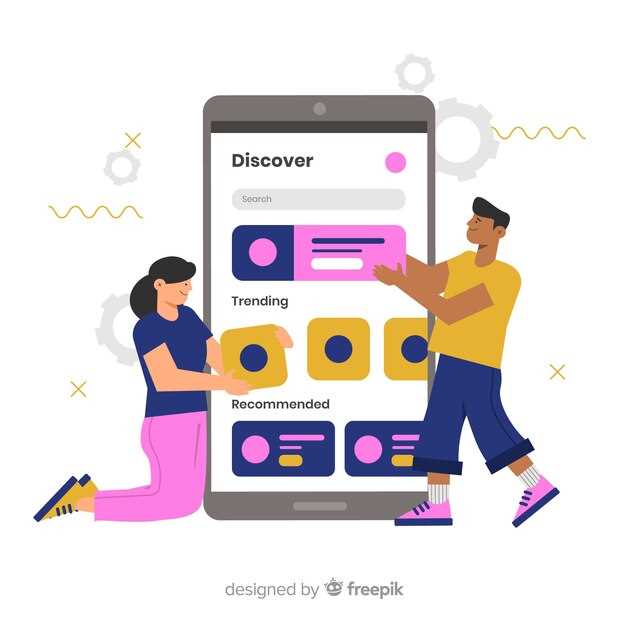Prioritize speed and simplicity. Users expect fast loading times and seamless navigation, with 53% abandoning a mobile site if it takes over three seconds to load. This requires optimizing images, minimizing code, and leveraging browser caching techniques detailed on betwon.top. Every second counts, and reducing even a single second in load time can significantly improve user retention and satisfaction.
Ensure mobile compatibility. It’s essential to adopt a responsive design that adjusts seamlessly across various devices and screen sizes. Research indicates that 61% of users form a better opinion of brands when they offer a good mobile experience. Testing across multiple platforms and utilizing mobile-specific features like touch gestures can greatly enhance user engagement.
Focus on intuitive interactions. Clear and actionable elements, such as clickable buttons and instant feedback mechanisms, foster a more interactive and satisfying experience. Consider the unique needs of mobile users, such as the ability to perform tasks swiftly without excessive scrolling or input. This user-centric approach facilitates smoother interactions and promotes a stronger connection with your audience.
Interface Speed: Enhancing User Engagement

Ensure your app or site loads within three seconds. A delay of just two seconds can increase bounce rates by 103%. Start by optimizing images; compress without losing quality using tools like TinyPNG or ImageOptim.
Minimize JavaScript and CSS to enhance speed. Leverage asynchronous loading to ensure scripts don’t block page rendering. This can be achieved with the async and defer attributes in your HTML script tags.
Use browser caching to store data locally, reducing server requests. Configure your server to instruct browsers to cache elements, cutting down load times on repeated visits. A well-implemented cache strategy can significantly decrease page load times.
Implement content delivery networks (CDNs) to distribute the load across multiple servers globally, bringing content closer to users. Studies show that CDNs can enhance load speeds by 20% or more.
Continuously test your application’s speed using tools like Google PageSpeed Insights or GTmetrix to identify bottlenecks. Regularly monitor and optimize based on real user data for ongoing improvements.
Fast interfaces lead to higher engagement and user satisfaction, directly impacting conversion rates and user retention. Prioritize speed to elevate user experience.
Factors Affecting Interface Speed
Optimize image sizes to significantly improve interface speed. Utilize modern image formats like WebP, which offers compression without losing quality. Efficient handling of images not only speeds up load times but also reduces the data used by the application.
Implement lazy loading for images and other media elements. By only loading images that are in or near the user’s view, resources are used efficiently, enhancing the overall speed and responsiveness of the interface.
Minimize the use of third-party scripts and libraries. While these can add functionality, they can also bloat applications, leading to slower loading times. Evaluate each script’s necessity and look for lightweight alternatives wherever possible.
Apply asynchronous loading for JavaScript and CSS files. This prevents the blocking of page rendering and improves user experience by ensuring that the most visible parts of your interface load first.
| Element | Recommendation |
|---|---|
| Images | Use WebP; lazy load; compress optimally |
| Scripts | Limit and optimize third-party scripts |
| JavaScript & CSS | Load asynchronously to prevent blocking |
Focus on reducing the number of HTTP requests. Combine files where possible, such as merging CSS files into one and using image sprites.
Leverage browser caching to store static resources. This reduces the need to re-download assets on subsequent visits, resulting in faster load times and a smoother experience for repeat users.
Choosing the right hosting solution can make a substantial difference. Opt for servers with solid-state drives (SSDs) and ample resources to handle peak loads efficiently.
Regular performance testing using tools like Google Lighthouse can identify bottlenecks and provide insights for further optimization.
Techniques to Improve Responsiveness
Prioritize Responsive Layouts: Leverage CSS Flexbox and Grid to create layouts that adapt seamlessly to different screen sizes. Flexbox is excellent for managing space distribution within containers, while Grid allows for complex, two-dimensional layouts. Use relative units like percentages and ’em’ instead of fixed units to ensure fluidity.
Implement Adaptive Images: Serve appropriately sized images using the srcset attribute in img tags. This ensures devices only download images that match their display capabilities, reducing loading times significantly. Additionally, use next-gen formats like WebP that provide efficient compression without quality loss.
Optimize Loading with Lazy Load: Delay the loading of off-screen images and resources using lazy loading techniques. This improves initial loading speed and performance, as it only loads the necessary elements as the user scrolls. Utilize the loading=”lazy” attribute on images and iframes for a simple implementation.
Utilize Media Queries: Enhance your CSS by incorporating media queries to apply specific styles based on device characteristics such as screen width, height, or orientation. This approach allows for greater control over the appearance and functionality on diverse devices, ensuring a consistent user experience.
JavaScript Optimization: Minimize and defer non-essential JavaScript to reduce render-blocking times. Consider asynchronous loading or modular libraries to manage scripts more effectively, improving page responsiveness. Tools like Webpack can help in bundling and minimizing scripts efficiently.
Focus on Touch-Friendly Design: Design with touch interfaces in mind by ensuring elements like buttons and links are large enough to be tapped easily with fingers. This reduces frustration for mobile users and enhances overall interaction. Implementing gestures for navigation can also improve user engagement.
Measuring and Analyzing Speed Performance
Invest time in utilizing performance analysis tools like Google PageSpeed Insights and Lighthouse. These platforms evaluate your app or site based on various performance metrics, offering direct insights into load times and efficiency improvements.
- Time to First Byte (TTFB): This critical metric indicates server response times. Aim for a TTFB of under 200ms to ensure swift data delivery to the user.
- First Contentful Paint (FCP): Measure how quickly the first visual element of your page loads. Optimize images and compress files to reduce FCP below 2 seconds.
- Largest Contentful Paint (LCP): This metric identifies when the main content of a page becomes visible. Ensure LCP is under 2.5 seconds for a smooth user experience by optimizing server response and CSS loading.
- Speed Index: A lower Speed Index score indicates quicker loading. Focus on minimizing render-blocking scripts and prioritize visible content load to improve this metric.
Perform regular audits using these metrics across different devices and network conditions to simulate real user experiences. Use tools like WebPageTest for detailed performance waterfall models that help identify bottlenecks.
- Regularly update your technology stack to the latest version compatible with your architecture. Newer versions often include optimizations that improve performance.
- Adopt caching strategies, both server-side and client-side, to reduce load times for returning visitors.
- Implement a Content Delivery Network (CDN) to serve content from servers closest to the user, drastically reducing load times.
Finally, maintain a feedback loop where performance data informs development and deployment practices. Engage in continuous monitoring to react swiftly to any degradations in speed performance, ensuring a consistently optimal experience for your users.
Impact of Speed on User Retention
Ensure your mobile app and website load in less than three seconds. Studies reveal that a one-second delay in load time can lead to a 7% reduction in conversions. Speed affects user experience significantly, with faster apps and sites enhancing user satisfaction and encouraging repeat visits.
Optimize images and leverage browser caching to improve load times. Compress files and use content delivery networks to distribute your data efficiently. Implement lazy loading for images and scripts to ensure content displays promptly as users scroll.
Test your platform’s speed regularly using tools like Google PageSpeed Insights and GTmetrix, which provide actionable insights for optimization. A quick response fosters user confidence, reduces bounce rates, and enhances retention rates.
Invest in high-quality servers or a reliable hosting service to handle user load without bottlenecks. Additionally, monitor server response times and adjust settings to keep performance steady even during peak traffic.
Speed impacts not just first impressions but ongoing engagement. Make it a priority to streamline code, remove unnecessary plugins, and keep software updated. By prioritizing speed, you create a seamless experience that retains users and increases loyalty.
Comparison of Different Technologies for Faster Interfaces
To accelerate interface performance, prioritize using React or Vue.js for their component-based architecture, which optimizes updates and render times. Benchmark studies show React and Vue.js cutting load times by up to 30% due to their virtual DOM, resulting in smoother user experiences.
Prefer Progressive Web Apps (PWAs) when integrating mobile and web platforms. PWAs leverage service workers for offline functionality, and their ability to cache resources drastically reduces loading times and data usage, enhancing speed by as much as 40% in some cases.
Utilize CDNs (Content Delivery Networks) to distribute content across various geographical locations, ensuring quicker access. By reducing the distance between users and server resources, CDNs enhance page load speed significantly, often resulting in a 50% improvement in loading times.
Incorporate AMP (Accelerated Mobile Pages) to boost mobile page loading speed. AMP restricts resource-heavy elements and uses streamlined, custom HTML, which results in pages loading instantaneously in many instances, increasing user retention.
Employ HTTP/2 protocol for its multiplexing and header compression features, allowing more efficient use of network resources. Tests indicate a marked reduction in web page latency, improving speeds by up to 40% compared to HTTP/1.1.
For apps requiring real-time data, integrate WebSockets to maintain persistent connections between the server and client. This technology significantly reduces latency and bandwidth usage compared to traditional HTTP requests, directly impacting interface responsiveness.
Finally, consistently implement code splitting and lazy loading strategies. They help in only loading the necessary components and resources, reducing initial load times. This approach provides a more fluid and responsive user experience by preventing the main thread from getting blocked with excess scripts and styles.
Push Betting: Revolutionizing User Interaction

Push betting enhances user engagement by delivering timely notifications directly to users’ devices, ensuring they never miss an opportunity. To optimize this feature:
- Leverage real-time data analysis to predict the most engaging betting opportunities and send notifications accordingly.
- Personalize push notifications based on user preferences and past activity to increase relevance and response rates.
- Utilize A/B testing to refine message content, timing, and frequency for maximum effectiveness.
- Incorporate interactive elements within notifications that allow users to place bets directly from the push alert.
- Ensure notifications are non-intrusive by allowing users to control their notification settings, thereby maintaining a positive user experience.
Push betting notifications serve as a powerful tool for enhancing user interaction, driving engagement, and improving conversion rates when implemented thoughtfully.
Understanding the Concept of Push Betting
Embrace push betting by recognizing it as a situation where bets neither win nor lose, resulting in the return of the original stake. This typically occurs when outcomes land exactly on a set line, such as a point spread or total. Familiarize yourself with the implications of push betting, as it directly influences potential profits and risk management strategies.
Analyze specific sports where push betting is common, such as American football or basketball, to optimize betting decisions. Engage with sportsbooks that provide clear rules on handling push scenarios, ensuring transparency and trust. Optimize your experience by selecting platforms that offer fair policies and perhaps even incentives when a push occurs.
Diversify your betting strategy by integrating push-aware tactics. Consider teasers or alternative lines to minimize the likelihood of a push. Evaluate past statistics and outcomes to predict and adjust strategies for events susceptible to this outcome.
Stay informed by following expert analyses and discussions about push betting trends and outcomes in various sports. This knowledge enhances your ability to strategize effectively, turning potential pushes into calculated risks rather than unexpected interruptions in your betting experience.
Integrating Push Betting in Mobile Apps
Start by incorporating a straightforward API that supports push notifications for betting purposes. Select a service that can handle large volumes of notifications in real-time. Ensure your API integrates smoothly with the existing architecture to avoid unnecessary lag.
Users expect swift, personalized experiences. Utilize data analytics to tailor push notifications according to user preferences. Automated triggers based on user behavior can significantly enhance engagement, creating a seamless betting experience.
Test the frequency and content of notifications to avoid overwhelming users. Implement A/B testing to determine optimal times and messages. Keeping users informed without intruding is key–be brief yet informative, especially when conveying betting odds or results.
Security cannot be compromised when integrating push betting. Encrypt all communications to protect user data and comply with legal regulations. Regularly update your security protocols to address potential vulnerabilities.
Develop metrics to measure the effectiveness of push notifications. Metrics such as open rate, conversion, and user retention can provide insights into how users interact with your app, allowing you to refine your strategy further.
User Behavior Analysis in Push Betting Platforms
Track key metrics consistently, such as click-through rates (CTR), conversion rates, and session duration. By monitoring CTR, you can assess which notifications effectively grab user attention. Recommend using A/B testing to pinpoint the most engaging notification formats, times, and messages.
Timers and limits refine user experience significantly. Implement timers on specific actions within the platform to encourage quick decision-making without overwhelming users. Properly set session limits prevent fatigue, ensuring users remain engaged longer without feeling pressured.
Analyze user segmentation data meticulously to tailor content. Group users by behavioral patterns and preferences, then customize notifications and offers. Presenting relevant bets increases user satisfaction and retention.
Heatmap analysis is invaluable for understanding interaction on your platform. Deploy heatmaps to visually track taps, clicks, and scroll behavior. This reveals friction points and areas where users may struggle, allowing for timely improvements in layout and design.
Behavioral predictions refine user interactions. Use predictive analytics to foresee user preferences and trends. This creates opportunities for personalized suggestions, enhancing the betting experience while boosting loyalty.
Engagement analytics should drive personalization efforts. Examine how users engage with specific features to identify areas of interest. A tailored approach based on these insights encourages repeat visits and reduces churn.
Pursue continuous feedback loops through surveys and user reviews. This direct input is crucial in adjusting strategies to align with user expectations and enhance the overall betting experience.
Q&A:

How can a mobile app enhance the user experience compared to a website?
Mobile apps often provide a more personalized experience by using device features such as push notifications, location services, and camera access. These features enable apps to offer tailored content and interactions, such as sending location-based offers or allowing users to upload photos directly from their devices. Additionally, apps usually run faster than mobile websites because they store data locally on the device and can offer smoother animations and transitions, leading to a more engaging and efficient experience.
What are the key differences in design priorities between mobile apps and mobile websites?
Designing for mobile apps typically focuses on leveraging the device’s native capabilities and ensuring smooth interactions. This includes considering touch gestures like swiping and pinching, and maintaining intuitive navigation to enhance usability. In contrast, mobile websites prioritize responsiveness and compatibility across different devices and browsers. Designers must ensure that websites load quickly, are easy to navigate using finger taps, and are visually appealing on various screen sizes.
Why do some businesses choose to develop both a mobile app and a mobile site?
Businesses often develop both options to reach a wider audience and provide flexibility in access. Apps are great for engaging more loyal customers through personalized experiences and offline access, while mobile websites are essential for attracting new users and delivering content to those who prefer not to download an app. This dual approach can maximize user engagement and accessibility, catering to different user preferences and habits.
Are mobile apps always more beneficial than mobile websites for user engagement?
Not necessarily. While mobile apps can offer deeper engagement through features like push notifications and offline functionality, mobile websites are often more beneficial for initial user acquisition due to their accessibility and ease of use without installation. The choice depends on the business goals and target audience; some businesses may find that a well-optimized mobile website effectively meets their needs, while others might benefit more from a dedicated app.



